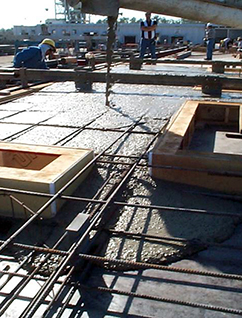
| HOME | ABOUT | APPLICATIONS | TECHNICAL | PROJECTS | LOCATIONS | CONTACT US | LINKS |
How Does Silica Fume Work in Concrete? |
 |
|
When silica fume is added to concrete, initially it remains inert. Once portland cement and water in the mix start reacting with each other (hydrating), primary chemical reactions produce two chemical compounds: Calcium Silicate Hydrate (CSH), which is the strength producing crystallization, and Calcium Hydroxide (CH), a by-product also called free lime which is responsible for nothing much other than lining available pores within concrete as a filler or leaching out of inferior concrete. Pozzolanic reaction occurs between silica fume and the CH, producing additional CSH in many of the voids around hydrated cement particles. This additional CSH provides the concrete with not only improved compressive, flexural and bond- strength but also a much denser matrix, mostly in areas that would have remained as small voids subject to possible ingress of deleterious materials.
The transport properties through the silica fume concrete medium are dramatically curtailed, i.e. liquid compounds and even electrical currents experience a diminished capability to migrate, resulting in very low permeability and high electrical resistivity. Silica fume’s benefits are already evident in the fresh concrete state before it begins to harden. Its small particle size which is 100 times finer than ordinary portland cement complements the finess modulus of concrete and provides a ball-bearing effect, which improves thixotropic behavior, in effect modifying concrete viscosity. Because of the high surface area of silica fume particles affecting the mobility of water within concrete, segregation and bleeding of concrete are virtually eliminated. Rheological benefits inherent in silica fume concrete allow for custom-tailoring concrete placement methods, such as very high cohesive workability, ability of fluid concrete to hold slope,and/ or long distance pumping of concrete. |

Silica Fume in concrete for High Performance, Durability, Viscosity and Sustainability  |
 The word pozzolanic is derived from the name of a town in Italy,
Pozzuoli. It was there that the ancient Romans combined ground
lime stone with volcanic ash to produce mortars to bind large stones
together. The durability of the resulting structures can still
be witnessed today, two thousand years later.
The word pozzolanic is derived from the name of a town in Italy,
Pozzuoli. It was there that the ancient Romans combined ground
lime stone with volcanic ash to produce mortars to bind large stones
together. The durability of the resulting structures can still
be witnessed today, two thousand years later.